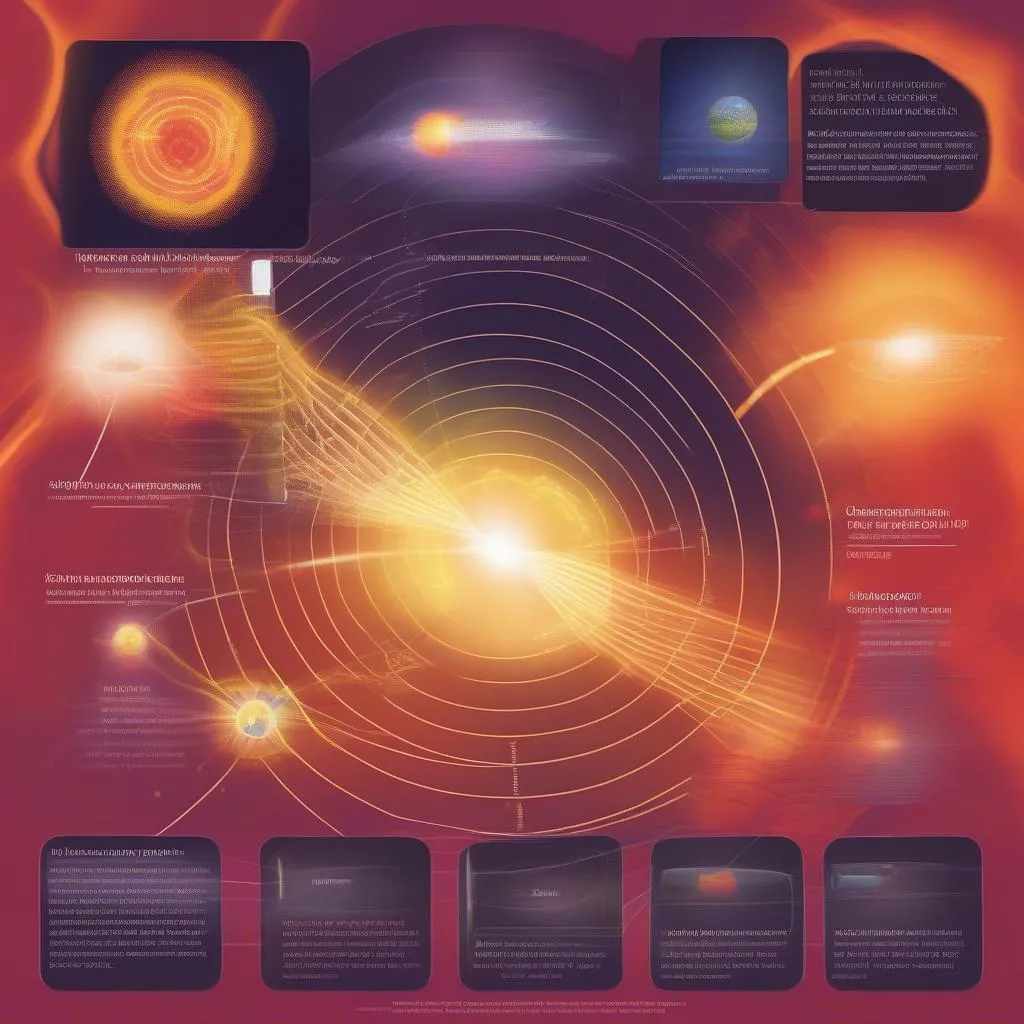Have you ever stood on a beach, feeling the warm sun on your skin, and wondered, “How did this heat travel millions of miles to reach me?” It’s a question that has fascinated humans for centuries. The sun, a star at the heart of our solar system, is a constant source of energy. But how does this energy actually reach us here on Earth? Let’s embark on a journey of light and warmth to understand this fascinating phenomenon.
The Sun’s Energy Factory: A Fusion Powerhouse
The sun isn’t burning like a fire; it’s actually a massive fusion reactor. Deep within its core, under immense pressure and heat, hydrogen atoms are forced together to form helium, releasing tremendous amounts of energy in the process. Imagine this energy as a bustling city center, full of light and activity. This is where our journey begins.
Traveling at the Speed of Light: The Role of Electromagnetic Radiation
The sun’s energy travels to Earth in the form of electromagnetic radiation. This radiation encompasses a wide spectrum, including visible light, infrared radiation (which we feel as heat), and ultraviolet radiation (which causes sunburns). This is similar to how a traveler might choose from different modes of transportation – a plane, a train, or a car – to reach their destination. Each form of radiation travels at the speed of light, an astonishing 186,282 miles per second.
A Vacuum-Sealed Journey: Through the Vastness of Space
Between the sun and Earth lies a vast expanse of space, a near-perfect vacuum. You might think this would make travel difficult, but electromagnetic radiation, unlike sound, doesn’t need a medium to travel. It’s like a message sent through the internet, independent of physical barriers. This allows the sun’s energy to traverse the 93 million miles to Earth unimpeded.
 Electromagnetic Radiation in Space
Electromagnetic Radiation in Space
Earth’s Atmosphere: A Protective Filter and Distributor
As the sun’s energy reaches our planet, it encounters Earth’s atmosphere. This protective layer absorbs some of the harmful radiation, like a security checkpoint filtering out potential threats. The atmosphere also plays a crucial role in distributing heat around the globe. Imagine it as a complex network of roads and highways, ensuring the sun’s warmth reaches even the most remote corners of our planet.
Life-Giving Energy: The Impact of Solar Energy on Earth
Once the sun’s energy reaches Earth, it fuels various processes essential for life. Plants use sunlight for photosynthesis, converting it into chemical energy and releasing oxygen. This process is the foundation of most ecosystems on Earth, much like how a country’s economy relies on its key industries. The sun’s warmth also drives our weather patterns, creating winds, ocean currents, and even influencing rainfall.
 Solar Energy's Impact on Earth
Solar Energy's Impact on Earth
FAQs about the Sun’s Energy and Earth
How long does it take for the sun’s energy to reach Earth?
It takes approximately 8 minutes and 20 seconds for sunlight to travel from the sun’s surface to Earth.
Why doesn’t space get hot even though the sun’s energy travels through it?
Space is a vacuum, meaning there are very few particles to absorb the sun’s energy. Heat is generated when energy is absorbed by matter, which is why space remains cold.
How does the Earth’s tilt affect the amount of solar energy received?
The Earth’s tilt causes different parts of the planet to receive varying amounts of sunlight throughout the year, leading to the changing seasons.
Planning Your Next Trip? Consider the Sun’s Influence
When planning your next adventure, consider the influence of the sun. Are you heading to the sunny beaches of Bali or the snow-capped mountains of Switzerland? Understanding how the sun’s energy affects different parts of the world can enhance your travel experience. For travel tips and inspiration, visit TRAVELCAR.edu.vn, your guide to exploring the world.
Remember: While the sun is a source of life and beauty, it’s important to protect yourself from harmful UV radiation. Wear sunscreen, sunglasses, and protective clothing, especially when traveling to sunny destinations.
By understanding how the sun’s energy travels to Earth, we gain a deeper appreciation for the delicate balance that sustains life on our planet. This knowledge adds another layer of wonder to our travel experiences, encouraging us to appreciate the intricate connections within our universe.


